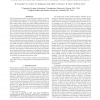Free Online Productivity Tools
i2Speak
i2Symbol
i2OCR
iTex2Img
iWeb2Print
iWeb2Shot
i2Type
iPdf2Split
iPdf2Merge
i2Bopomofo
i2Arabic
i2Style
i2Image
i2PDF
iLatex2Rtf
Sci2ools
ICASSP
2011
IEEE
2011
IEEE
On visually evoked potentials in eeg induced by multiple pseudorandom binary sequences for brain computer interface design
Visually evoked potentials have attracted great attention in the last two decades for the purpose of brain computer interface design. Visually evoked P300 response is a major signal of interest that has been widely studied. Steady state visual evoked potentials that occur in response to periodically ickering visual stimuli have been primarily investigated as an alternative. There also exists some work on the use of an m-sequence and its shifted versions to induce responses that are primarily in the visual cortex but are not periodic. In this paper, we study the use of multiple m-sequences for intent discrimination in the brain interface, as opposed to a single m-sequence whose shifted versions are to be discriminated from each other. Speci cally,
| Added | 21 Aug 2011 |
| Updated | 21 Aug 2011 |
| Type | Journal |
| Year | 2011 |
| Where | ICASSP |
| Authors | Hooman Nezamfar, Umut Orhan, Deniz Erdogmus, Kenneth E. Hild II, Shalini Purwar, Barry Oken, Melanie Fried-Oken |
Comments (0)

